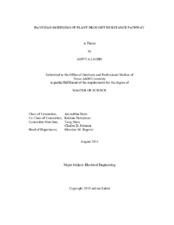| dc.contributor.advisor | Datta , Aniruddha | |
| dc.contributor.advisor | Narayanan, Krishna | |
| dc.creator | Lahiri, Aditya | |
| dc.date.accessioned | 2019-01-18T14:48:01Z | |
| dc.date.available | 2020-08-01T06:37:21Z | |
| dc.date.created | 2018-08 | |
| dc.date.issued | 2018-07-31 | |
| dc.date.submitted | August 2018 | |
| dc.identifier.uri | https://hdl.handle.net/1969.1/173972 | |
| dc.description.abstract | Plants are sessile organisms and are unable to relocate to favorable locations under extreme environmental conditions, and hence they have no choice but to acclimate and eventually adapt to the severe conditions to ensure their survival. With climate change affecting the environment adversely, it is of utmost importance to make plants and crops robust enough to withstand harsh conditions and safeguard global food production. As traditional methods of bolstering plant defense against stressful conditions come to their biological limit, we require newer methods that can allow us to strengthen the plant’s internal defense mechanism. This motivated us to look into the genetic networks of plants. In this thesis, we lay out a method to analyze genetic networks in plants that are activated under abiotic stress, specifically drought conditions. This method is based on the analysis of Bayesian networks and should ultimately help in finding genes in the genetic networks of the plant that play a key role in its defense response against drought.
The WRKY transcription factor is well known for its role in plant defense against biotic stresses, but recent studies have shed light on its activity against abiotic stresses such as drought. Therefore, it is logical to study the various components of the WRKY gene network in order to maximize a plant’s defense mechanism. The data used to learn the parameters of the Bayesian network consisted of both real world and synthetic data. The synthetic data was generated using the dependencies in the Bayesian network model. The network parameters were learned using a Bayesian approach and the frequentist approach. The estimated parameters are then used to build a Bayesian decision network, where nodes are selected one at a time for intervention and the utility (score) for the upregulation of a downstream abiotic stress response gene is computed. The node that maximizes this utility is recommended for biological intervention. | en |
| dc.format.mimetype | application/pdf | |
| dc.language.iso | en | |
| dc.subject | Bayesian Networks | en |
| dc.subject | Gene Regulatory Network | en |
| dc.subject | Parameter Estimation | en |
| dc.subject | Inference | en |
| dc.subject | WRKY Transcription Factor | en |
| dc.subject | Drought | en |
| dc.subject | Pathway | en |
| dc.subject | Arabidopsis | en |
| dc.title | Bayesian Modeling of Plant Drought Resistance Pathway | en |
| dc.type | Thesis | en |
| thesis.degree.department | Electrical and Computer Engineering | en |
| thesis.degree.discipline | Electrical Engineering | en |
| thesis.degree.grantor | Texas A & M University | en |
| thesis.degree.name | Master of Science | en |
| thesis.degree.level | Masters | en |
| dc.contributor.committeeMember | Shen, Yang | |
| dc.contributor.committeeMember | Johnson, Charles D. | |
| dc.type.material | text | en |
| dc.date.updated | 2019-01-18T14:48:01Z | |
| local.embargo.terms | 2020-08-01 | |
| local.etdauthor.orcid | 0000-0001-9352-1312 | |


